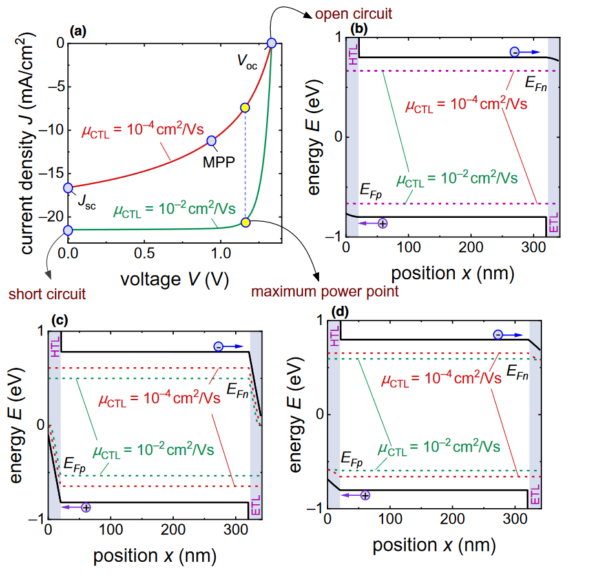Akel, S.; Kulkarni, A.; Rau, U.; Kirchartz, T.
PRX Energy 2023, 2, 013004
Diffusion lengths are abundantly mentioned as a key enabler of high performance in lead-halide perovskite solar cells based on the implicit assumption that diffusion lengths are directly connected to efficient collection of charge carriers. While long diffusion lengths are indeed an important factor for highly efficient solar cells, they are a poor descriptor of efficient collection in the presence of undoped and low-mobility transport layers. Especially, the presence of low permittivity and organic electron- and hole-transport layers that are predominantly used in p–i–n-type perovskite solar cells can lead to substantial concentrations of electrons and holes within the perovskite absorber, as evidenced by measuring the photoluminescence at short circuit. These high carrier concentrations can lead to the seemingly odd situation in which charge collection at short circuit can be inefficient, even though the diffusion length substantially exceeds the absorber thickness. We use experiments, as well as analytical and numerical modeling, to define the requirements for both absorber and contact layers to enable efficient collection in perovskite solar cells.

Akel, S.; Kulkarni, A.; Rau, U.; Kirchartz, T.
PRX Energy 2023, 2, 013004
Diffusion lengths are abundantly mentioned as a key enabler of high performance in lead-halide perovskite solar cells based on the implicit assumption that diffusion lengths are directly connected to efficient collection of charge carriers. While long diffusion lengths are indeed an important factor for highly efficient solar cells, they are a poor descriptor of efficient collection in the presence of undoped and low-mobility transport layers. Especially, the presence of low permittivity and organic electron- and hole-transport layers that are predominantly used in p–i–n-type perovskite solar cells can lead to substantial concentrations of electrons and holes within the perovskite absorber, as evidenced by measuring the photoluminescence at short circuit. These high carrier concentrations can lead to the seemingly odd situation in which charge collection at short circuit can be inefficient, even though the diffusion length substantially exceeds the absorber thickness. We use experiments, as well as analytical and numerical modeling, to define the requirements for both absorber and contact layers to enable efficient collection in perovskite solar cells.